In powerlifting, there is one number that is paramount above all others: The Total. One of the most important, and yet forgotten, aspects of technique selection for each movement is not only how it will affect that lift, but how it will affect your total.
For example, many people claim that benching with a big arch tires out their back for deadlifts. Others claim that using a wide stance squat coupled with a sumo pull leaves their hips too tired at the end of the meet. Further still, some people say that narrow squats have a higher rate of carryover to the deadlift than wide stance squats. And to be fully honest, there are people that say the exact opposite of everything I’ve just said!
Who is Right?
This article is not going to be about helping you find “The One True Way”. As with most things in powerlifting, technique selection is incredibly nuanced and there are so many variables in play that, most of the time, you simply have to experiment and “find what works for you”.
However, that doesn’t mean there aren’t starting points for personal experimentation that make more sense than others. Though I’m generally not a fan of merely copying what the best guys are doing, I thought doing a short statistical analysis of the squat and deadlift technique pairings of the top American deadlifters might shed some light onto what squat techniques lead to the biggest pull at the end of the meet.
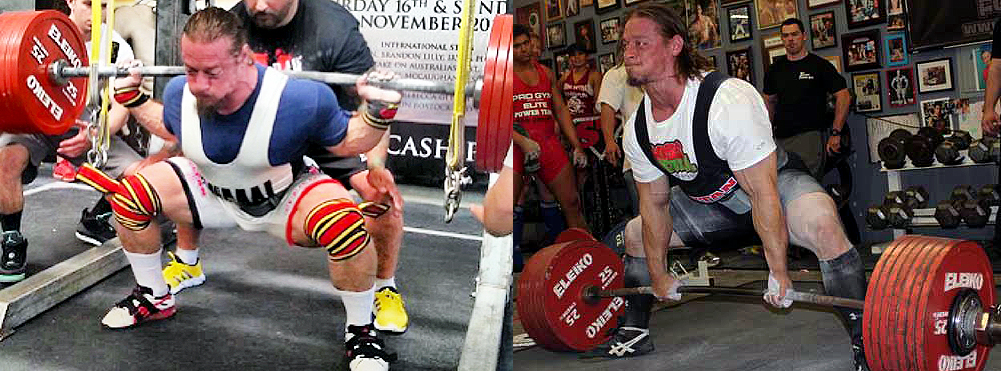
Here’s multiple-time World Record Holder Dan Green’s Squat/Deadlift technique pairing. Photo:lift.net
Setting up the Study
In order to select the lifters which I would analyze, I used PowerliftingWatch.com’s All-Time American Rankings. I used the Top 5 Deadlifts from each weight class up to 275lbs. If the lifter did not perform the lift at a full meet, I either used numbers from that lifter that did occur at a full meet or, where I could not find full meet data on a lifter, I simply moved down to the next lifter on the list.
Just to give you an idea of the caliber of lifters that were studied, here are ten guys that were included in this study: Eric Lilliebridge, Dan Green, Stan Efferding, Jesse Norris, Brandon Cass, Vashon Perryman, Richard Hawthorne, Perry Ellis, Ernie Lilliebridge Jr, Brantley Thornton, and Kade Weber.
Caveats and Context
I think it is important to keep in mind that this study only includes American lifters. This is going to predispose the data to a number of biases. Lifters from other countries pull sumo in much higher frequencies than here in the USA.

“Foreign” All-Time World Record holders such as Belyaev and Pozdeev were not included in this study.
Additionally, because I focused on the top deadlifters, most of these guys are going to have body types that are naturally suited to the deadlift. Likewise, because the two go hand in hand, in many cases, they will have body types that aren’t particularly suited to the squat. Because of this, I think it is less important to consider each variable in isolation and more important to consider them together in context.
Simply put, we need to focus on the technical pairings of each style rather than how many people use a specific style. For example, it is more useful to know that wide stance squatters prefer sumo deadlifts than it is to know that most deadlifters, in general, do not prefer the sumo deadlift.
With that in mind, let’s crunch the numbers.
Pulling Style, Squat Stance, and Bar Placement
People outside of the sport often bitch about sumo deadlifts, but the reality is that most of the top American deadlifters pull conventional style. Of the 40 lifters cataloged, only 12 pulled Sumo or 30%.
In terms of squat stance, 8 squatted “narrow” (20%), 17 squatted “medium” (42.5%), and 15 squatted “wide” (37.5%). For the purposes of the study, I defined the stance widths as following:
a) Narrow — clearly inside shoulder width stance
b) Medium – approximately shoulder width stance
c) Wide – clearly outside shoulder width stance
In terms of squat bar placement, 23 lifters used the low bar position (57.5%) and 17 used the high bar position (42.5%).
Analyzing the Combinations
As I said, this data is interesting, but it isn’t as revealing as when we start to look at how top lifters combine their techniques for best results.
For example, of the 12 sumo pullers, only 1 preferred a narrow stance. Seven (58.3%) preferred a wide stance. Of the 28 conventional pullers, only 8 preferred a wide stance (28.5%). 13 preferred a medium stance (46%) and 7 preferred a narrow stance (25%).
In terms of bar placement, only 1 sumo puller used high bar. However, the majority of conventional deadlifters squatted high bar with 16 of them preferring the higher bar position (57%).
Taking Everything Into Consideration
If we consider all three variables simultaneously, further insights can be gleaned. For conventional deadlifters who used the low bar squat, 10 out of 12 (83%) preferred a medium or wide stance. For conventional pullers who used a high bar squat position, 13 out of 16 (81%) preferred a narrow or medium stance. The sumo pullers were even more segregated; 11 of the 12 sumo pullers preferred a low bar position with a medium or wide stance.
The two single most popular combinations were:
a) Conventional Deadlift; High Bar, Narrow Stance Squat, 8 of 40 (20%)
b) Sumo Deadlift; Low Bar, Wide Stance Squat, 7 of 40 (17.5%)
What did we learn?
I think there are several important facts to point out here:
- Most of the best deadlifters used a squat stance similar to their deadlift stance
In terms of carryover, this makes a great deal of sense. The more similar the stance, the more similar the biomechanics of the two movements are going to be. This is going to lead to greater rates of transference to the deadlift when a lifter drives his squat up.
- Low Bar squats are not universally preferred by Conventional Pullers
There are many of us who feel pretty strongly about the superiority of the low bar squat for powerlifting, but this particular data set very clearly shows that most conventional pullers actually prefer a more quad dominant squat pattern. The majority squatted high bar and the vast majority used a narrow or medium stance; both of these technical changes are going to emphasize the quads to a greater degree.

Kade Weber demonstrates the high bar, narrow stance squat and conventional deadlift combination. Photo: animalpak.com
- Low Bar squats are heavily preferred by Sumo Pullers
In direct contrast to conventional pullers, low bar squats were nearly unanimously chosen by sumo pullers. This too makes a great deal of sense. The low bar squat exchanges a less upright back angle for far more posterior chain and hip involvement. For a sumo puller who relies on posterior chain strength as it is, it logically follows they’d use a squat technique that also allowed them to take advantage of those strengths.
The Raw Data
By request, I am uploading the raw data for which this study was based on: Squat to Deadlift Carryover Data.
Like this Article? Subscribe to our Newsletter!
If you liked this articled, and you want instant updates whenever we put out new content, including exclusive subscriber articles and videos, sign up to our Newsletter!
Questions? Comments?
For all business and personal coaching services related inqueries, please contact me:
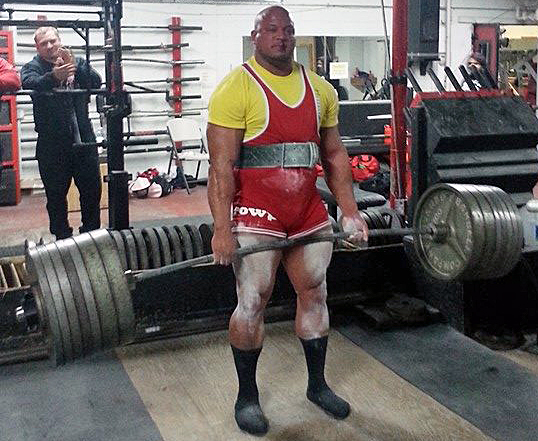
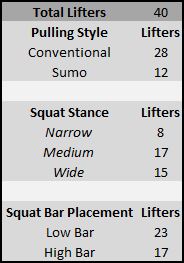
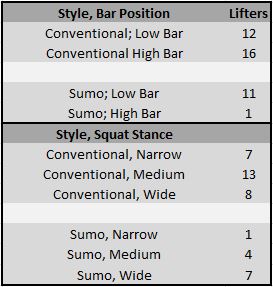
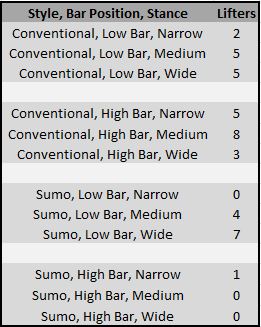

I’d be interested to see the same analysis done on say the top 3 of each weight class of ipf raw worlds.
That would definitely be cool. I think it would be tough to get good footage of foreign lifters that would allow me to accurately catalogue their techniques. I’ll think about it for a future article though.
What 3 lifters squat high bar& wide, and pull conventional?
Perry Ellis, David Troutt, and Brantley Thornton.
Would you consider my stance to be medium?
https://www.youtube.com/watch?v=UGlHoXTKW1g&t=18
I’d have classified that as wide. Feet pretty clearly look outside shoulder width to me. In retrospect, perhaps I should have had “wide” and “very wide” categories.
That’s good to hear. I’m pretty sure I can go even wider, especially with the extra mobility work I’ve been doing : )
You said, “For a sumo puller who relies on posterior chain strength as it is, it logically follows they’d use a squat technique that also allowed them to take advantage of those strengths.”
I thought that a sumo pull puts less stress on the posterior chain vs. conventional. Isn’t sumo more quad dominant? I may be missing something here.
Conventional deadlifts use more hamstrings and lower back than Sumo pulls, sure, but, because the hip angle is more acute in a sumo deadlift, more degrees of hip extension are required to complete the movement. A sumo deadlift vastly increases adductor recruitment (from minimal to full recruitment) and also substantially increases glute recruitment. So, my statement was a bit obtuse. Hope that clarifies things.
Gotcha. Thanks for the quick reply : )
No problem, Steve-O
Hey, great site, good information!
Any way you could make the whole list available, who lifts what way (and in what fed)?
Given that over 40% of the top lifters squat high-bar, does that make you want to soften your statement on the other page that “low bar is nearly universally superior … with exceptions” ?
I’ve just uploaded the raw data to the end of the article. You can find the spread sheet here: http://www.powerliftingtowin.com/wp-content/uploads/2014/04/squat-deadlift-carryover-data.xlsx
This doesn’t particularly change my stance for a variety of reasons. For one, I personally have experienced that most lifters don’t actually “think” about these things. They just do what is comfortable and natural for them.
Given that I specifically studied the top deadlifters, and not the top lifters in terms of total, we’re predisposed to a bias where most of these guys have favorable deadlift builds and poor squat builds. Generally speaking, that means shorter torsos and longer legs. These are the guys who struggle the most with low bar because of how bent over they get. High bar is one logical way to stay more upright. It is my current stance, based on my arguments elsewhere, that there are better ways to stay upright without sacrificing leverage.
I’d definitely say that it does present an interesting argument in favor of high bar, though. Even if you lift less weight high bar compared to low bar, one might successfully argue that, for conventional pullers, the seemingly higher rate of transference from high bar is worth squatting a bit less. Ultimately, we’d need to actually test lifters with multiple styles to see what they can do. That isn’t going to happen so, for now, we’re limited to observational analyses like this one.
I hope that helps. Let me know if I can clarify anything further!
I was initially thinking of a question, “how do the top lifters in terms of TOTAL” do the Squat and Deadlift, but in all probability, the top 40 totals will probably have a HUGE amount of overlap with the top 40 Deadlifts.
.
After all, the Deadlift is the biggest contributor to the total for pretty much every lifter ever, and averages about 40% of the total. So the top 40 DL will probably make up 30+ of the top 40 totals.
.
One other thing I thought of: most likely there is some correlation between style of lift and Federation. For example, if the Fed uses a specialty Deadlift bar, it’s more likely that a lifter can get more with a Sumo pull than a Conventional pull, because the closer grip means more bend, and a higher start and better position for the lift, before the plates break off the ground. Your thoughts?
You’re right; there would definitely be MASSIVE overlaps. One thing that I might do is run some sort of a regression based on Wilks score to see which combinations are most effective rather than simply tallying them all up.
I do think that deadlift bars provide a preferential advantage to sumo pullers. However, most of the people on this list pull with deadlift bars because most of the top American deadlifters lift in untested federations. Most untested federations use deadlift bars.
My experience has shown me, though I don’t have the data to back it up at this time, that sumo is more prevalent in the lighter weight classes and that it decreases in popularity fairly markedly with each jump in weight class.
I was surprised there were so many high bar squatters. Then I looked at the picture of Kade Weber which you say is high bar, and he is *clearly* squatting low bar (the bar is below his traps, on his deltoids, rather than sitting *on* his traps. Vashon Perryman also clearly squats low bar. So I think you must have miscalculated and/or not fully grasp the difference between high bar and low bar…
Did you do a similar study with top female Deadlifters as well? I’m a narrow stance “good morning style” squatter and narrow stance conventional deadlifter. I know myself and some of the other female lifters out in the powerlifting world would be interesting in seeing such results.
I didn’t. Unfortunately, it is hard to consistently find videos of the top female lifters. I will definitely try to do this in the future, though. I think it would be instructive especially because there is a popular notion that female lifters more often benefit from the sumo style than male lifters.